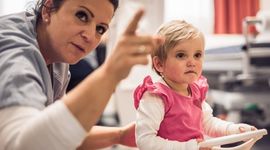Birth of a Child suspected to have EB
When open sores, blisters or areas of missing skin are detected on a baby after birth, the pediatrician or the health personnel will then rule out all other diseases that are present with the same symptoms. Once other diseases were ruled out (particularly infections), you rather quickly have to think of epidermolysis bullosa.
In a nutshell we’ll give you an overview of the main features in the care of a child with epidermolysis bullosa. Initially it is not so important what form of EB your child has, as at the beginning of life the approach is very similar. As soon as the exact form of EB is known, the care of the child can be adjusted gradually.
Most important:
- Aim for a rapid diagnosis when all other blistering causing diseases have been ruled out (skin biopsy for immunofluorescence / antigen mapping, genetic analysis).
- Band-Aids and other sticky materials (i.e. ECG electrodes) should not be used! When removing the band aids or other glued materials the vulnerable skin often sticks. The fixation can be carried out with adherent, but non-adhesive material (i.e. Mepitac®, Mepilex®). In an emergency situation you will / can make an exception. It is essential to peel the used plaster (band aid) etc. very gently using the help of a "medical adhesive remover" (e.g. Niltac ®) or leave it alone and contact an EB specialist.
- The same is true for peripheral venous catheters ( I.V.), which can be necessary for infusions. The fixation can also be carried out with adherent, but non-adhesive material (e.g. Mepitac ®, Mepilex ®). If you can only fixate one bandage - upon removal of all other types of sticky type dressing bandages - proceed as described above.
- Blood draws and injections are possible, when preparing the skin for the procedure please clean the area with disinfectant spray or gentle application avoiding friction or rubbing of the skin. After removal of the needle do not use a band aid, use a fixating light pressure bandage.
- Even babies with EB need touch and contact with their parents! If possible you should avoid lifting the baby from under the armpits. It would be better if you first put the baby on a small soft padding, such as a sheepskin, a soft blanket or pillow thus, the baby is lifted together with the underlying padding and in this way, other injuries will be avoided.
- The baby should only be placed in an incubator if medically necessary (i.e. a premature birth) as the warmth from the incubator can lead to increased formation of blisters.
- Dressing technique (initial and continuing care of open skin areas)
1. Direct contact wound dressing: no adhesive gauze (with or without Vaseline). When it is available you can also use Mepilex ® a nice soft foam dressing suitable for EB skin.
2. Padding: with soft nonwoven gauze sponges
3. Fixation: with soft gauze or possibly tubular bandage
A dressing change every 2 days is usually enough. This can be done in a tempered not to warm bath allowing the bandages to soak off. - Pain treatment - prevent pain by using a suitable dressing. Not all babies with EB cry because of pain, so watch them carefully! Medical pain therapy is best in liquid/drop form (if possible).
- While dressing the baby try to avoid pressure points in the clothing and diapers.
- Breast feeding is often possible and it should be tried. When it does not function the use of a bottle with special nipples (i.e. „Haberman®-Sauger“) can be helpful.
- You should contact an EB center for further advice!

